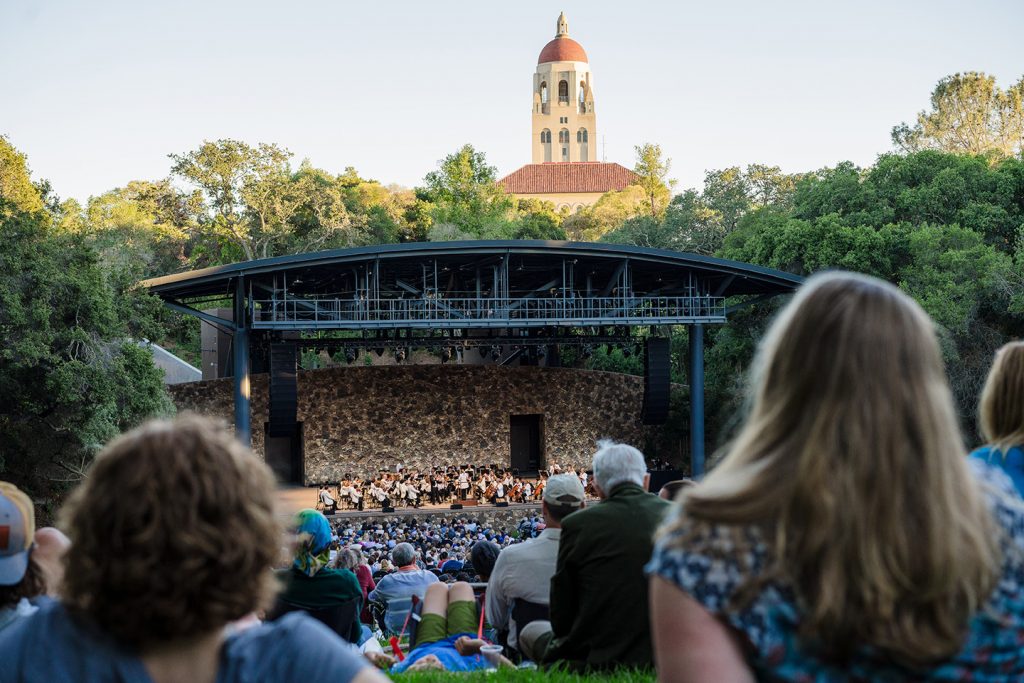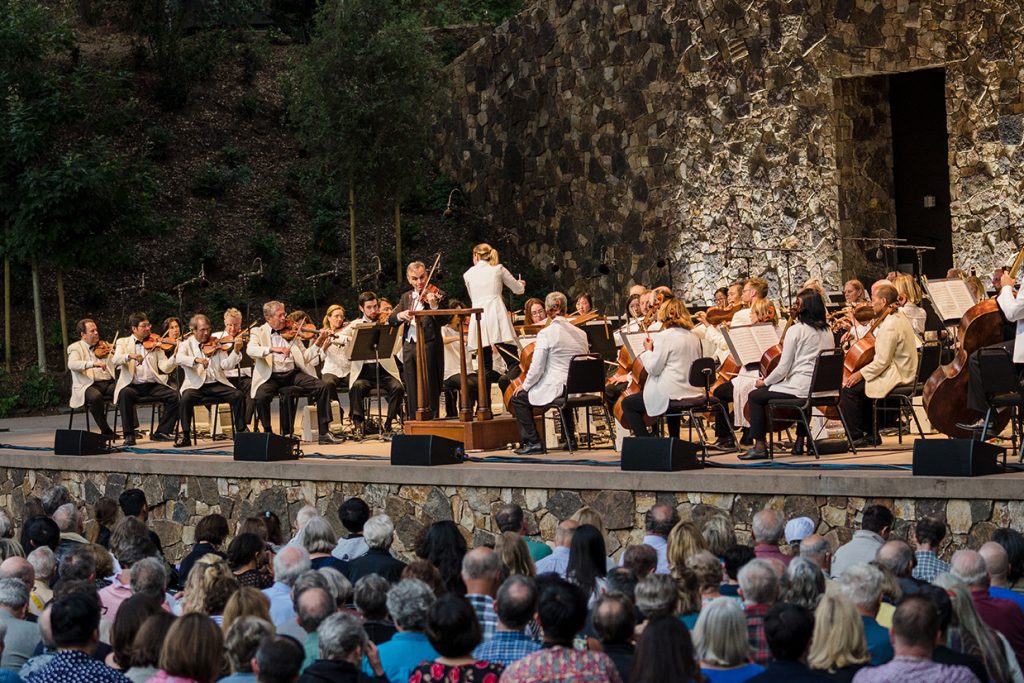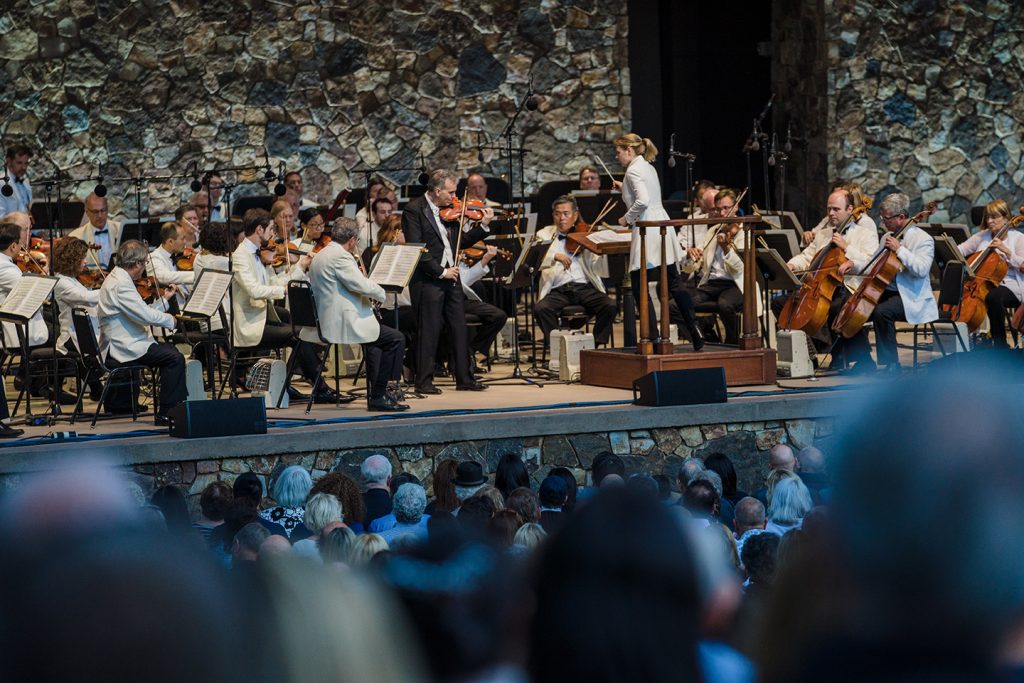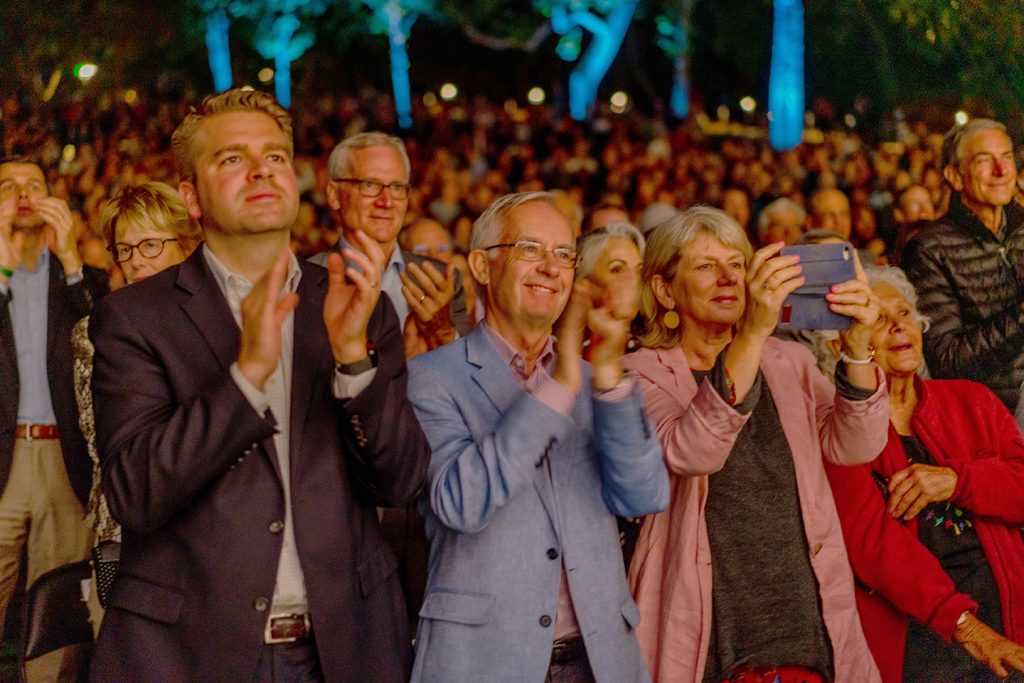
Henry Etzkowitz and Chunyan Zhou
Stanford University’s glorious tradition of outdoor classical music is restored to rightful place among its peers, the classic summer symphonic venues of Chicago Symphony Orchestra’s Ravinia Pavilion in Highland Park, Illinois and Boston Symphony’s Berkshire Tanglewood Music Center, with the recent re-opening of Frost Amphitheater.
It is hopeful hype that such is the intended follow on to the renewed Frost Amphitheater’s initial two concerts featuring San Francisco Symphony performances of Tchaikovsky’s 5th and Beethoven’s 9th symphonies. The Symphony’s association with Stanford dates from an initial 1913 concert on campus and an iconic performance marking the 50th anniversary of the university at Frost, with annual summer concerts during the 1960’s and 70’s, with link retaken through the January 2013 inauguration of the Bing concert hall. This sporadic connection is a long way from the symbiotic relationship of Southern Oregon University to the Ashland Shakespeare Festival in which Stanford also played a supporting role but it is one that may be instructive to the future of the arts/university relationship.

Previously left to return to nature, dilapidate; Frost has been smartly restored and updated with a formidable roofed and pillared stage. The dark black open-air stage, both solid and neat, is cool! The stark stage offsets the surrounding natural vegetation, the rugged earth and stone pattern, reprising mid 20th century southern California house entryways on a massive scale, as a background wall shining under the yellow light. Near capacity audiences spread out over the serrated open air site divided into a lower folding chair formal seating venue and an upper blanket picnic friendly area. The outdoor symphonic venue is designed to create a romantic and inviting summer night on campus! The Laurence Frost Amphitheater, commonly known as Frost Amphitheater, opened in 1937 and was the site of commencement ceremonies for the university from 1938 until 1984. The audience is invited to picnic on the lawn in the hours before the performance. The very long security entry lines on Thursday, delaying the performance start, were resolved by Saturday.
Bring on the Music!
Opening the series, with his heart and full enthusiasm, violinist Gil Shaham performed elegantly the only violin concerto of Tchaikovsky (1878). Allegro moderato (D major) — 4/4 beat, sonata, showing the joy of life via Russian folk music. Canzonetta: Andante (G minor) — Short song, board, G minor, 3/4 beat, three-segment, “small love songs” , with moving and slightly sad main melody. Finale: Allegro vivacissimo (D major) — 2/4 beat, roundabout sonata form, from Russian folk dance music Trebak, “showing” a picture of celebrating the festival. Shaham’s performance accompanied his facial expressions; sometimes cheerful with his smile; other times soothing with peace memorably showing on his face. During the intermission, we moved back to the grass, enjoying the summer night on the soft lawn, eating halibut and tomato sandwiches, fresh fruit, with drink; watching the elegant audiences here and there, discussing the first half of the performance.

The musical leadership of female New Zealand-born conductor, Gemma New, is quite amazing. Several times, the lady sitting on our left said “She is unbelievable!”. Gemma’s body movements include both the tenderness of the woman and the power and strength, which is manifested by the large sway of the body and the firm pause of the arms in the air. In addition, the graceful back lines of her body also catch the audience’s attention, not only that of the performers.
The orchestra also played Tchaikovsk’s Symphony No.5 in E minor, Opus 64 (1888). I like Andante cantabile, con alcuna licenza. It is performed as something that can shock people’s hearts and can touch my soul. Its rhythm is very soothing, creating a romantic and poetic atmosphere. The Finale is always my favorite piece, especially its beginning.

From the beginning of Andante maestoso, to the middle of Allegro vivace and the more lively Molto vivace, until the final Presto, has been enhancing our sense of dignity. Listen to this piece with Brass in the open air, amazing! Although there are neither percussion instruments, like drums and cymbals, nor enough pipe music instruments, what is remarkable is, just using its strong those string instruments, the Symphony can also perform a spectacular and powerful ending!
Saturday night, Frost Amphitheater on Stanford University campus, looked particularly fascinating in the semi-circular moonlight. It is a perfect arrangement to put Ravel’s Shéhérazade together with Beethoven’s Symphony No.9, showing both masculine and feminine beauty. Shéhérazade was sung by mezzo-soprano, Kelley O’Connor. Her voice is so fascinating, pure and clear. In Asie a process from a European fantasy of distant Asian enticements, Arabia, India and China, back to the real world, is reproduced perfectly. In La Flûte enchantée., she profoundly expresses a mixture of sad and joyful emotions. San Francisco Symphony gives the text in its Summer with the SF Symphony, which increases the audiences’ understanding of the music.
Beethoven’s Symphony No. 9, put orchestra and chorus together, with Mary Evelyn Hangley (Soprano), Kelley O’Connor (Mezzo-soprano), AJ Glueckert (Tenor) and Adam Lau (Bass). At the beginning of the choral , Adam’s performance is very impressive; Mary’s voice is bright and beautiful; AJ Glueckert’s full of magnetism; and Kelley, affectionate and gentle. Everyone collaborates! When the familiar “Ode to Joy” melody sounded, one could only wish that peace and joy be with us everyday!
Back to the Future
An occasional aircraft sound reminds that Frost is on the Palo Alto flight path to SFO and a looming helicopter that we are not far from the Stanford Hospital helipad. While the latter is necessary, the former could possibly be mitigated by a request to reroute flights during performance time. The redoubtable heiress and public concert entrepreneur, Minnie Guggenheimer, sponsor and organizer of the New York Philharmonic summer concerts for forty years, was reputed to have persuaded the New York airport authorities to fly elsewhere than upper Manhattan during concerts. At least this is what she assured prospective audience members during her regular appearances on the Tex and Jinx radio talk show, broadcast from the Waldorf Astoria’s Peacock Alley in the early 1950’s.
City College of New York’s Lewisohn Stadium is long replaced by the university’s engineering school and the upper Manhattan concert series, accessible to a working class constituency arriving by public transportation, is a fond memory while the exurban, now suburban, Stanford Frost amphitheater site is perhaps at the cusp of a new variegated summer music and performing arts festival reprising the too short-lived avante–garde Pepsico festival at State University of New York Purchase in the early 1970’s.
The Ashland Oregon’ Shakespeare Festival, discussed in Making a Humanities Town [1] Etzkowitz, H. Triple Helix (2015) 2: 1. See.https://link.springer.com/article/10.1186/s40604-014-0012-z provides a model for a strong university-arts collaboration that invigorates and sustains both partners in the venture, going well beyond providing a venue for an outreach site. Perhaps, having regained Frost, we may next experience a revival of the Stanford Shakespeare Festival, originally organized in the 1930’s by the redoubtable Stanford English professor, Margery Bailey, a humanities entrepreneur, theatre performer and university teacher. The Stanford festival, however, was discontinued after a few seasons by the Humanities Dean of the time who thought that university sponsorship of summer performances were not academically appropriate.

Professor Bailey went on to infuse the Ashland Shakespeare Festival with her academic expertise in Elizabethan theatre as well as perform on its stage. The Stanford connection to Ashland is a continuing one, with Bailey’s adaptation of the geological field work tradition of bringing Stanford students to the Ashland Festival reprised by Prof. Ivo Javic’s recent seminar Learning Theater: From Audience to Critic at the Oregon Shakespeare Festival, including a thirteen day field trip. Perhaps, it would now be synergistic for the informal collaboration between the two schools to be enhanced with Ashland Shakespeare’ Festival performances at Frost, reprising the Festival’s own history of Bay area performance.

The Frost Amphitheater renewal is a significant step in creation of an arts quarter, highlighting the role of the visual and performing arts, in a technology oriented school. Over the decades Stanford’s entrepreneurial tradition has spread from Engineering to Medicine and the computational sciences, with only occasional arts expression, like the Music School’s Yamaha patents. Perhaps, the time is ripe for an iconic University Innovation system that has filled many of the translational gaps between academia and industry, to be more fully adapted to the university’s humanistic, arts and publication programs.
More information about the San Francisco Symphony
Photos: Brandon Patoc


Be the first to comment